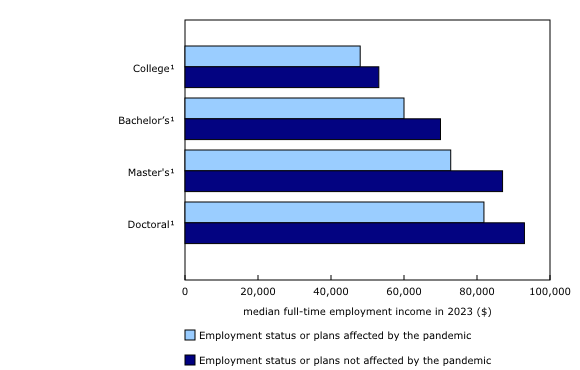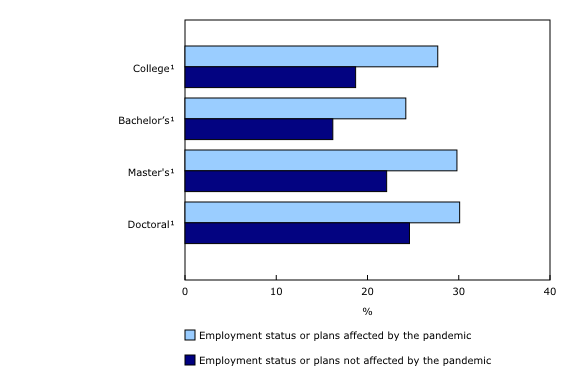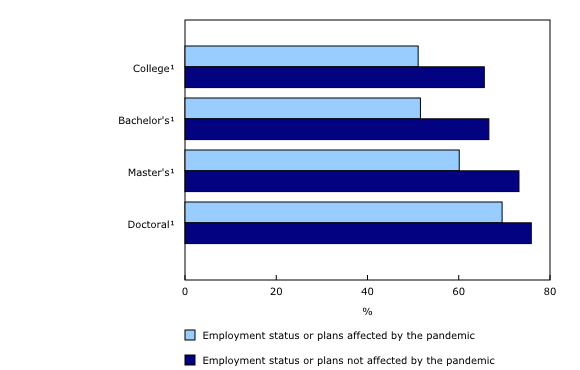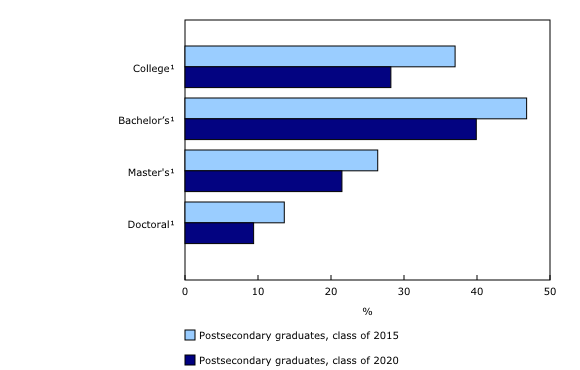The impacts of the COVID-19 pandemic on the postsecondary graduating class of 2020
Released: 2024-03-22
The postsecondary graduating class of 2020 faced unique challenges as it entered the labour market during the initial waves of the COVID-19 pandemic. Results from the National Graduates Survey reveal that over half (55.6%) of those who graduated in 2020 saw their employment status or employment plans change at some point that year as a result of the pandemic.
About 3 in 10 graduates (30.6%) lost their job or were laid off in 2020, while nearly 1 in 4 (23.6%) had an employment prospect—such as a scheduled interview—cancelled. Around 1 in 10 (9.6%) graduates experienced a delay in the start date of a new job, while 8.8% had a job with a confirmed start date cancelled.
Changes to employment status or employment plans were more common among college (58.3%) and bachelor's (55.8%) graduates than among master's (47.3%) and doctoral (45.9%) graduates. This finding aligns with a study which found that 'triple-protected' jobs—defined as those that have no predetermined end date; have a low risk of being lost or transformed due to automation; and which are resilient to the effects of the COVID-19 pandemic—are less likely to be held by those with a bachelor's degree than by those with a graduate degree.
Early pandemic-related disruptions affected labour force activity for some graduates three years later
Despite the labour market challenges faced by the class of 2020, their employment rate three years after graduation (90.3%) was similar to that of 2015 graduates (89.9%). The 2023 employment rate for 2020 graduates was slightly higher than the 2023 employment rate for the overall Canadian core working age population (aged 25 to 54 years) with a postsecondary certificate or diploma (87.3%).
Those in the 2020 graduating class who experienced pandemic-related changes to their employment status or employment plans were just as likely to be employed, but were less likely to be working full-time three years later (79.7%) than those who did not experience these changes (83.8%). When examined by level of study, this was also the case for bachelor's and doctoral graduates, while the proportion of college and master's graduates who were employed full-time was similar regardless of whether they experienced pandemic-related changes to their employment status or employment plans.
Additionally, the 2023 unemployment rate for all graduates who experienced pandemic-related changes to their employment status or employment plans in 2020 was more than twice as high (7.5%) compared with those who did not experience changes of this kind (3.6%). For comparison, the 2023 unemployment rate was 4.0% for the Canadian core working age population (aged 25 to 54 years) with a postsecondary certificate or diploma. This pattern was also observed for college, master's and doctoral graduates but not for bachelor's graduates.
Graduates who experienced a pandemic-related change to their employment status or employment plans in 2020 were more likely to have a lower employment income three years later
Analysis released at the onset of the pandemic estimated that its potential impact on graduates could have long-term ramifications on graduates' earning prospects.
On the one hand, three years after graduation the median incomes (in 2023 constant dollars) of full-time employed college ($48,800), bachelor's ($62,300) and doctoral ($87,600) graduates from the class of 2020 were similar to those of their 2015 counterparts.
On the other hand, among 2020 graduates, those whose employment status or employment plans were affected by the pandemic in 2020 had a lower median annual employment income across all levels of education, ranging from 9.6% lower for college graduates to 16.3% lower for master's graduates. This pattern held true when controlling for field of study.
Graduates who experienced a pandemic-related change to their employment status or plans in 2020 were more likely to feel overqualified for their job in 2023 and less likely to hold a job closely related to their program
On the one hand, the proportions of 2020 graduates who reported that they felt overqualified for their job three years after graduation (22.9%) or that it was strongly related to their program of study (59.5%) were similar to those of the class of 2015.
On the other hand, as of 2023, graduates from the class of 2020 who experienced pandemic-related changes to their employment status or employment plans in 2020 were more likely than those who did not to feel they were overqualified (26.6% versus 18.4%) and less likely to feel that their job was strongly related to their 2020 program of study (52.7% versus 67.5%).
The pandemic also had an impact on further education plans of 2020 graduates
Following graduation, postsecondary graduates may pursue further studies for a variety of reasons, including to boost career prospects and earning potential. Three years after graduation, 32.4% of 2020 postsecondary graduates had pursued further education, compared with 39.7% for their 2015 counterparts. Similar differences were observed across all levels of postsecondary education.
The fact that fewer 2020 graduates had pursued further education three years after graduation than their 2015 counterparts may be the result of many factors. The rapid shift to remote learning in postsecondary institutions which began in March 2020 and remained largely in place until the fall of 2021 may have contributed to some students deciding to cancel or postpone plans for further studies. More than one in three (34.3%) 2020 postsecondary graduates changed their plans for further education. More specifically, 10.1% of graduates delayed their further studies, while 11.0% decided not to pursue further studies. Conversely, 9.4% chose to pursue further studies.
For some graduates, the pandemic appeared to have a lasting effect on their education plans. For example, among the proportion of graduates who reported that they delayed their further education (10.1%), 37.4% had begun a new program within three years of graduating from their 2020 program.
Did you know we have a mobile app?
Get timely access to data right at your fingertips by downloading the StatsCAN app, available for free on the App Store and on Google Play.
Note to readers
Today's release provides a first look at the effects of the COVID-19 pandemic on 2020 graduates three years after graduation. Accompanying the release are tables with data on postsecondary graduates and labour force activity, earnings and student debt. Data are available by province of study and location of residence at the time of the interview.
The target population for the National Graduates Survey (NGS), class of 2020 corresponds to graduates of public postsecondary educational institutions in Canada during the 2020 calendar year who were living in Canada at the time of the interview in 2023.
Only graduates from programs at a college or university level which are three months' duration or longer are in-scope for NGS. Graduates with a trades or vocational certificate or diploma are not included in the NGS.
Labour outcome terminology and definitions:
All analysis on labour market outcomes excludes graduates who pursued further postsecondary education between graduation and the time of the interview.
Working full time refers to usually working 30 hours or more per week at a single job or business.
Level of postsecondary education terminology and definitions:
College includes college or other non-university certificates, college or other non-university diplomas, CEGEP certificates, and CEGEP diplomas.
Bachelor's includes bachelor's degrees, degrees in medicine, dentistry, veterinary medicine and optometry, university certificates below bachelor's degrees, and university diplomas below bachelor's degrees.
Master's includes master's degrees, university diplomas above bachelor's degrees, and university certificates above bachelor's degrees.
Products
The data visualization tool "Estimated gross annual earnings and student debt of postsecondary graduates in Canada: Interactive tool," part of the Statistics Canada - Data Visualization Products (71-607-X) series, is available.
Contact information
For more information, or to enquire about the concepts, methods or data quality of this release, contact us (toll-free 1-800-263-1136; 514-283-8300; infostats@statcan.gc.ca) or Media Relations (statcan.mediahotline-ligneinfomedias.statcan@statcan.gc.ca).
- Date modified:




